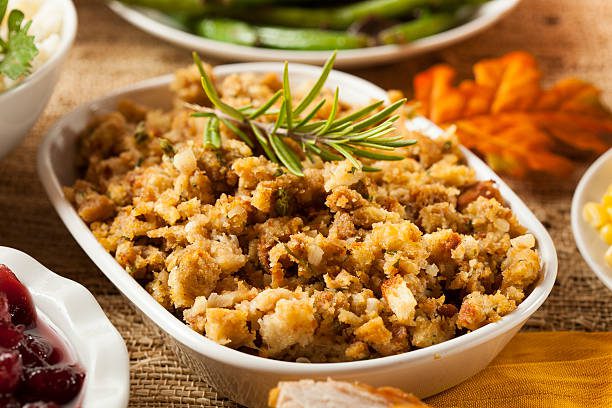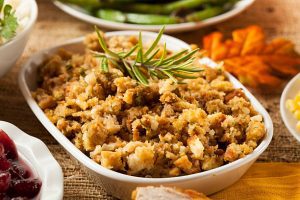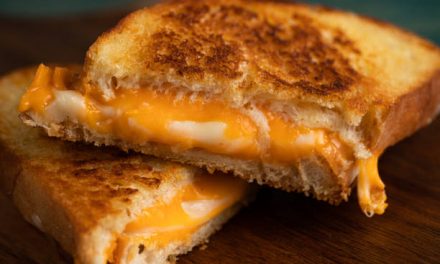“The delicious flavor of the sage really stands out in this classic recipe”
Ingredients
- 3 –cups French bread cut into cube size bits
- 1 large white onion chopped
- 1 clove garlic peeled and finely diced
- 1 bunch celery washed and chopped do not include the stem base
- 1 teaspoon sage
- 4 cups turkey stock
- 1 teaspoon Sea salt
- ½ teaspoon freshly ground black pepper
Preparation
- Add the cut French bread to a large mixing bowl along with the onion, garlic, celery and sprinkle with salt, pepper and sage and gently stir.
- Add the turkey broth 1 cup at a time until the bread becomes moist but not wet.
- Place stuffing into a baking pan.
- Bake for 1 hour or until stuffing reaches a temperature of 175 degrees F.
Holiday Stuffing Success Guide
Holiday turkey stuffing is the warm, aromatic heart of the feast—crispy at the edges, plush at the center, saturated with roasted drippings and herbs. Though “stuffing” technically cooks inside the bird and “dressing” bakes in a separate dish, most families use the words interchangeably. Whatever you call it, great stuffing balances texture (toasty and custardy), seasoning (savory with bright accents), and moisture (juicy, not soggy). Here’s an all-in-one ABOUT to help you choose ingredients, dial in technique, and honor tradition while keeping food safety front and center.
A quick history: bread-based stuffings trace to ancient Mediterranean cooks who used stale loaves to soak up meat juices. In North America, colonists combined Old World habits with New World ingredients—cornbread, wild rice, oysters, chestnuts, cranberries—creating a tapestry of regional styles. The South leans cornbread and sage; New England loves oysters and butter; the Midwest embraces white-bread cubes with celery and onion; the Pacific Northwest tosses in mushrooms and fresh herbs. What links them is frugality and flavor: day-old bread transformed by stock, aromatics, and fat into a celebratory centerpiece.
Bread choice is the backbone. Use sturdy, open-crumb loaves that toast well and absorb stock without collapsing—country white, sourdough, pain de mie, or a 50/50 split with cornbread for sweetness and tender crumb. Cut into ½–¾-inch cubes and dry them: either air-dry overnight on trays or toast in a low oven until lightly golden. Well-dried cubes are your insurance against gluey stuffing.
Aromatics create the signature stuffing perfume. Classic mirepoix—onion, celery, carrot—sautéed in butter (or butter plus olive oil) forms the base. Add garlic for warmth, fennel for sweetness, or leeks for mellow depth. Herbs define the holiday profile: sage for savory backbone, thyme for woodsy lift, rosemary sparingly for piney pop, and parsley for freshness. Consider a little acid balance (splash of dry white wine to deglaze or a teaspoon of cider vinegar in the stock) to brighten richness.
Moisture management is the art. Warm, well-seasoned stock (turkey, chicken, or vegetable) should be added gradually until cubes are glossy and evenly hydrated but still hold their edges. Eggs (one per 4–6 cups of bread) bind and enrich; heavy cream or melted butter amplifies custard-like tenderness. If you love crisp tops and custardy centers, bake in a wide, shallow casserole. For maximum contrast, finish uncovered to brown, then tent if the top threatens to over-darken before the middle sets.
Mix-ins personalize the pan. Pork sausage browns into savory nuggets; bacon provides smoke and fat for sautéing; mushrooms bring umami; chestnuts add sweetness and meaty bite; dried fruit (cranberries, apricots) introduces tart pops; nuts (pecans, walnuts) deliver crunch. Keep the ratios thoughtful: for every 10 cups of bread, aim for ~3 cups aromatics, 1–2 cups cooked add-ins, 3–4 cups stock, and 2–3 eggs, adjusting to taste and desired texture.
Food safety matters. If you plan to stuff the turkey, do it right before roasting with freshly mixed, cold stuffing—never the night before. Roast until a probe in the center of the stuffing reaches 165°F (74°C). Undercooked stuffing can harbor bacteria even when the turkey’s breast reads done. Many cooks prefer baking stuffing separately to control texture and temperature, then finishing with a ladle of hot pan drippings for authenticity without risk.
Special diets are easy to accommodate. For gluten-free versions, choose high-quality GF loaves or a mix of GF cornbread and brown-rice bread; dry them thoroughly for structure. For vegetarian stuffing, use rich vegetable stock, olive oil or plant butter, and umami boosters like sautéed mushrooms or a touch of white miso. Reduce sodium by selecting low-sodium stock and salting aromatics in layers instead of all at once.
Make-ahead strategy keeps the day sane. Toast bread cubes up to a week ahead (store airtight). Sauté aromatics two days ahead. On the morning of, combine, season, and add stock/eggs just before baking. You can assemble and refrigerate (tightly covered) for a few hours, then bake; add a splash of warm stock if the top dries while waiting. Leftovers reheat beautifully: sprinkle with stock, cover with foil, and warm until steaming, then uncover to re-crisp.
Serving ideas push stuffing beyond the side dish. Spoon it into roasted squash halves, fold into a turkey pot pie, crisp patties in a skillet for next-day brunch with eggs, or blitz leftover bits with stock for a cozy “stuffing soup.” The goal, always, is contrast and comfort—golden crust, custardy core, and aromas that call everyone to the table.
References:
https://www.fsis.usda.gov/food-safety/safe-food-handling-and-preparation/poultry/stuffing-and-food-safety
https://www.foodsafety.gov/food-safety-charts/safe-minimum-cooking-temperature
https://www.seriouseats.com/how-to-make-stuffing-and-dressing-for-thanksgiving-5187757
https://www.thekitchn.com/how-to-make-classic-bread-stuffing-237545
https://www.kingarthurbaking.com/blog/2017/11/09/best-bread-for-stuffing
https://extension.umn.edu/preserving-and-preparing/roasting-turkey-safely
All Recipes by Chef Ed Health and Fitness Talk








